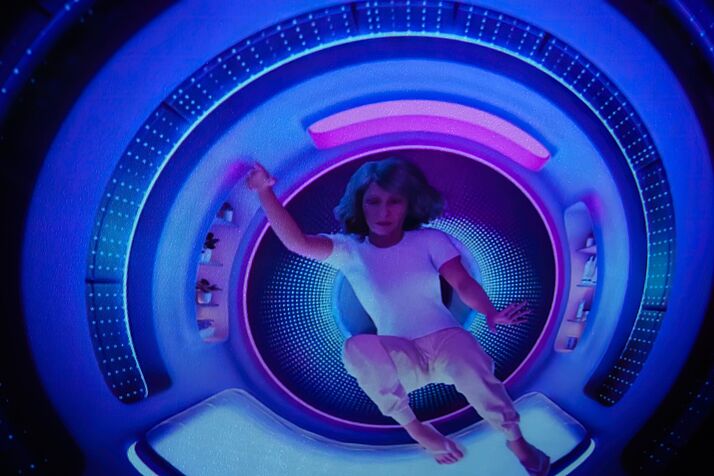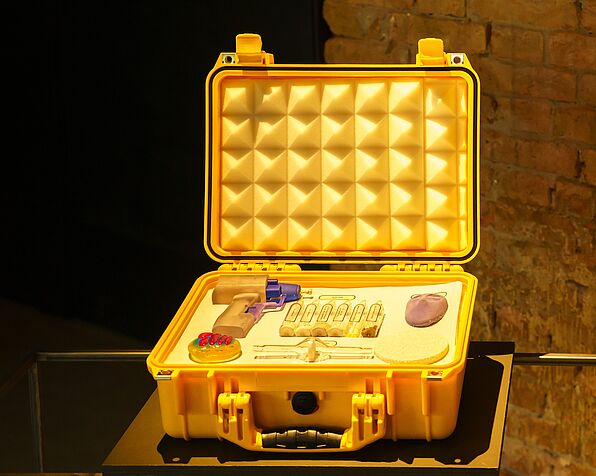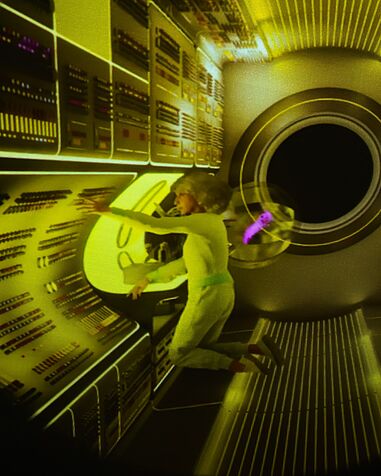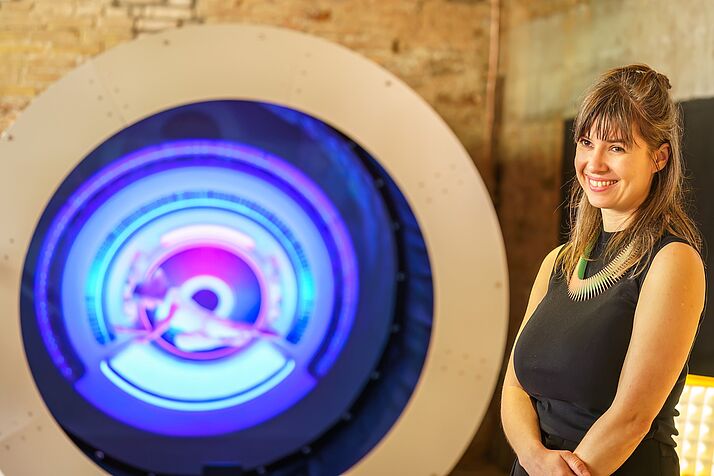Liftoff from the Universe Pavilion at Biennale 2025 in Venice
Univie Joins Chief Bioengineer Mira Kordan to Boldly Go Where No One Has Gone Before
What does it take to sustain human life on a long journey through deep space? Could fungi form the backbone of a self-sufficient life support system? Artist Kristina Pulejkova, in collaboration with the scientists Diethard Mattanovic (BOKU), Matthias Steiger (TU Wien), and Jürgen Zanghellini (UniVie) and supported by acib GmbH, explores this bold vision. Her multidisciplinary project “The Metabolic Guide to Space Survival” is now on view at the Venice Biennale’s Universe Pavilion.
Kristina Pulejkova’s installation The Metabolic Guide to Space Survival invites us to reflect on a pressing question: how might humanity sustain itself on long-duration space journeys? To answer, we step into a life-size tunnel replicating the interior of the starship Möbius, where a holographic projection of Chief Bioengineer Mira Kordan floats through laboratory spaces and living quarters.
Her fictional guidebook, written from aboard the Möbius at age 75, lays out how to establish microbial-based life support systems and develop DIY medical solutions—transforming advanced bioengineering into a hands-on survival toolkit. Highlights include a fully developed three-course microbial menu and a vivid yellow suitcase filled with essentials: sourdough starters, a gene gun, and a zero-gravity bioreactor to kickstart life support far from Earth.
And what if we replace “space” with “Earth”? Then the question becomes an urgent inquiry into the sustainability of human life in the face of future challenges on our own planet. By blurring the lines between science fiction and reality, Pulejkova’s work not only showcases cutting-edge research but also challenges us to consider the ecological, ethical, and philosophical stakes of human expansion.
Kristina Pulejkova was selected from 153 applicants in an open call for the ARTcib SciArt Residency in 2024. During her residency, she collaborated with Prof. Jürgen Zanghellini, head of the Chemical Bioinformatics Network Analysis and his team at the Faculty of Chemistry, University of Vienna.
Together, they developed a model of a yeast-based bioreactor and evaluated strategies for its optimal operation. This bioreactor is envisioned as the heart of the starship’s life support system, designed to supply essential precursor materials for all aspects of life aboard the fictional vessel.
The key challenge: how to ensure optimal performance of the reactor? If you extract material from the reactor faster than the microorganisms can grow, you gradually reduce the number of cells until they’re all gone—at which point the entire fermentation process fails.
"Obviously, this is bad news if microbial fermentation is the backbone of your life support system on a spaceship bound for Mars," explains Jürgen Zanghellini. "The question that interests me, a computing nerd, in such a situation is: At what dilution rate should I operate the fermenter to maximize the production of cell material per minute to best run my life support system?"
Surprisingly, the optimal operating point isn't when the reactor contains the highest number of cells. Instead, it lies just beyond that peak—where cell numbers begin to decline. In some scenarios, this ideal point may even be perilously close to the washout threshold. Zanghellini reflects: "If the sweet spot in fermentation is just before disaster, does that mean life is best lived at the edge of a cliff—close to falling, but never quite tipping over? That’s a question I never asked – but Kristina did. And my math says yes."
The Metabolic Guide to Space Survival is part of the exhibition Sheltering in Space – A Guide, curated by Claudia Schnugg. The exhibition brings together architectural models, speculative design, performance, and art to explore how we create refuge—physically, socially, and imaginatively. It asks us to rethink how we make a place for ourselves—and to envision the forms of shelter we might need in uncertain futures
The exhibition opens opens May 10 and runs through June 30, 2025, at the Universe Pavilion, as part of the Venice Biennale of Architecture 2025.
In the Media
- Science meets Arts -Marsflüge müssten radikal recyceln (orf Science, 22.05.2025)
- Recycling-Essen für Weltraumforscher (Mayrs Magazin - Wissen für alle, 16.05.2025)






